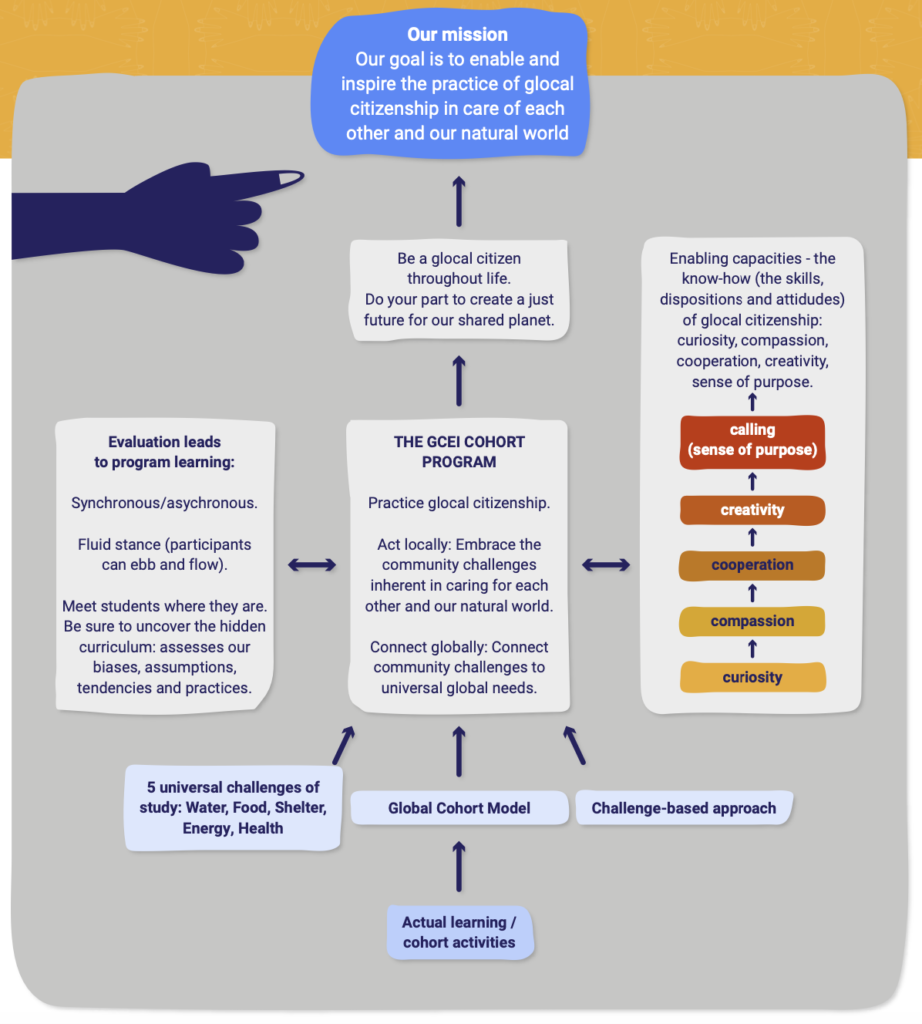OUR MODEL

PEDAGOGICAL PROCESS
GCEI’s pedagogical process is designed to ensure every student learns with deep
understanding. Students work in collaboration to make excellent ongoing progress in their
learning and build skills in applying knowledge to real life situations in their own contexts.
The goal is to provide every student with strong foundational knowledge of vital issues. By exploring these topics with students around the world, students develop a critical awareness of international mindedness and environmental stewardship. They develop skills to build a better future, not only for themselves but for their own communities.
The short and long-term vision is for such a process to guide teachers in nurture wonder and ignite passion. By providing every young person with knowledge, skills and attributes, GCEI helps prepare them for a lifetime of meaningful actions and effective future citizenship, strengthening youth participation in environmental and climate decision-making processes.
The short and long-term vision is for such a process to guide teachers in nurture wonder and ignite passion. By providing every young person with knowledge, skills and attributes, GCEI helps prepare them for a lifetime of meaningful actions and effective future citizenship, strengthening youth participation in environmental and climate decision-making processes.
Challenge-based approach

Unlike a problem, a challenge isn’t something we encounter, it’s something we choose. Its
meaning is imbued with a sense of will—to oppose, dispute, or claim. In situations, the problem is why we act and the challenge is how we act. The problem is the situation and the challenge is the response. When we ignore the problem it gets worse; when we overcome the challenge, things get better.
As a global population, GCEI encourages youth, not just to identify the problems regarding the five critical issues that make up the Areas of Service, but to choose and rise to those local and global challenges in order to come up with responses to the problems and thus develop international mindedness and environmental stewardship.
GCEI’s Challenge-based Learning is based on the CBL Guide*, an effective learning framework initiated at Apple, Inc. that empowers Learners (students, teachers, administrators and community members) to address local and global Challenges making an immediate impact on the world while acquiring content knowledge in math, science, social studies, language arts, medicine, technology, engineering, computer science and the arts. The Challenge Based Learning framework emerged from the “Apple Classrooms of Tomorrow—Today” (ACOT2) project initiated in 2008 to identify the essential design principles of a 21st-century learning environment.
GCEI’s Challenge-based Learning is based on the CBL Guide*, an effective learning framework initiated at Apple, Inc. that empowers Learners (students, teachers, administrators and community members) to address local and global Challenges making an immediate impact on the world while acquiring content knowledge in math, science, social studies, language arts, medicine, technology, engineering, computer science and the arts. The Challenge Based Learning framework emerged from the “Apple Classrooms of Tomorrow—Today” (ACOT2) project initiated in 2008 to identify the essential design principles of a 21st-century learning environment.
Approaches
Challenge Based Learning is designed to be flexible, customizable and allow for multiple
perspectives. From CGEI work, this approach can extend school curricula, serve as the framework for the development of environmental projects, and act as an overarching framework for decision
making and learning, while giving the students real-life opportunities to perform actions that can have an impact in their communities.
Challenges create a sense of urgency and spur action. In Challenge Based Learning, they include a specific structure (engage, investigate and act), vary in duration and intensity and can be incorporated or adapted to most learning environments. These variations will mainly depend on the time available and the age of the students, having shorter projects for younger participants.
Challenges create a sense of urgency and spur action. In Challenge Based Learning, they include a specific structure (engage, investigate and act), vary in duration and intensity and can be incorporated or adapted to most learning environments. These variations will mainly depend on the time available and the age of the students, having shorter projects for younger participants.
Setting
Challenge Based Learning is unique in that part of what is considered "teacher work" in traditional settings (e.g. researching content, aligning standards, and developing assessments) is completed with the students during the Challenge experience. Success with Challenge Based Learning necessitates providing structure, support, checkpoints and the right tools to get work done, while still allowing space for self-directed, creative, and inspired learning.
As the process into Phases 1, 2 and 3 advances with the students, the GCEI Cohort Managers will go back to the Setting stage to make any adjustments and modifications necessary to enhance the teaching and learning experience.
As the process into Phases 1, 2 and 3 advances with the students, the GCEI Cohort Managers will go back to the Setting stage to make any adjustments and modifications necessary to enhance the teaching and learning experience.
